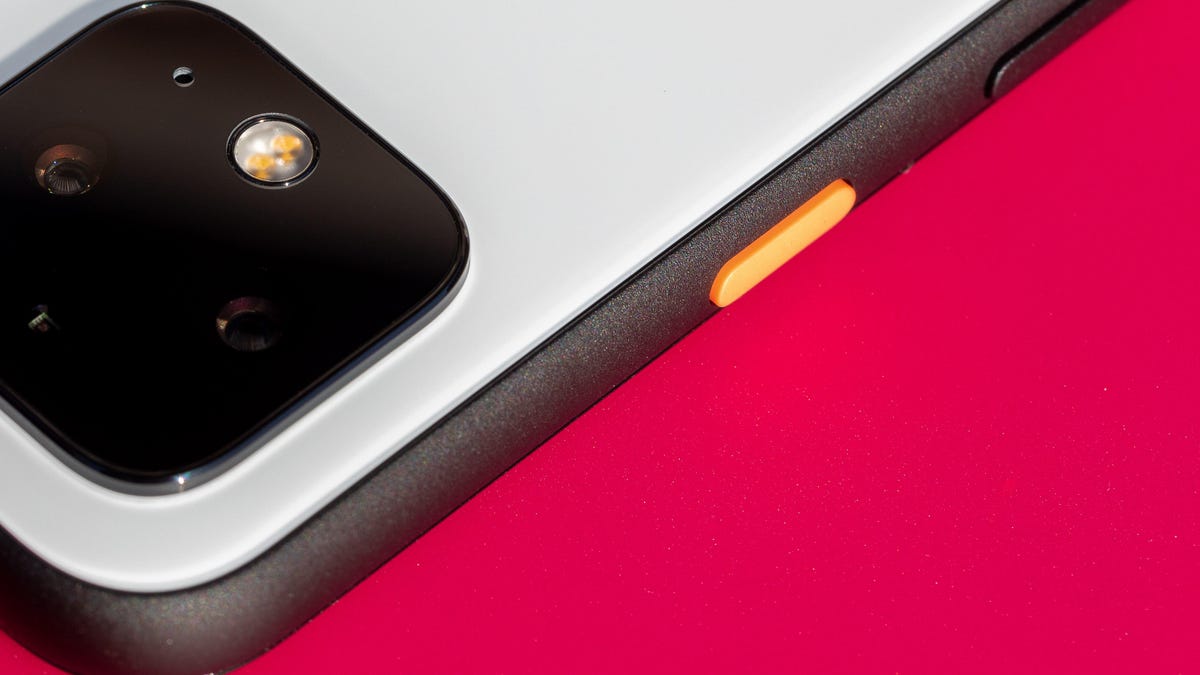Virtual buttons could make your 2020 phone more waterproof
UltraSense thinks its technology will be more reliable than physical buttons and just as easy to use.

Like the bright orange power button on Google's Pixel 4? It could become a relic, replaced by virtual buttons.
Get ready to say bye to buttons. Next year, some phones will replace the physical buttons for power and volume with ultrasonic sensors that power virtual buttons. The benefits include better waterproofing and durability, at least in the eyes of startup UltraSense Systems that's hoping to capitalize on the idea.
When it's time to mash the power button or crank up the volume on today's phones, you're most likely depressing a button that physically moves. UltraSense, coming out of stealth mode Tuesday, has now detailed its first product, a tiny chip package just 1.4mm by 2.4mm across and 0.5mm deep that generates inaudible sound waves.
The sensor, which will be demonstrated at CES next month, is called TouchPoint and can figure out if you're pressing a button by analyzing how those sound waves disperse or reflect. It also can tell when it shouldn't respond, like from water splashing or keys bumping, said UltraSense Chief Business Officer Dan Goehl.
The top five phone companies are evaluating or incorporating TouchPoint sensors, and the first phones using them should arrive in mid-2020, UltraSense said. The phone makers like the technology because it means they don't have to cut holes for real buttons into phone chassis and line them with gaskets to keep liquids out, Goehl said. And the sensors cost about the same as physical buttons, about $2.
It's not yet clear whether UltraSense will show up in flagship phones or lower-profile models where manufacturers might be willing to take more of a risk. But the trend in the computing industry is clear: moving parts and mechanical components are disappearing.
"Consumers prefer real buttons because we're wired to like tactility," said Techsponential analyst Avi Greengart. "But sometimes the benefits -- waterproofing, cost, durability, design -- trump that."
The UltraSense TouchPoint sensor is dwarfed by a penny.
No moving parts
There are lots of examples of disappearing physical controls. Apple's first iPod had a rotating wheel, soon replaced by a touch-sensitive pad that could tell virtually when you were twirling your finger. More recently, Apple dropped the home buttons on iPhones and iPads , freeing up room for bigger screens and moving the industry toward swipe gestures instead.
Hard drives with spinning platters are vanishing from personal computers, replaced by solid-state drives. MacBook trackpads no longer have hinges but instead simulate finger-push clicks with a tiny motor. Devices cool enough to run without whirring fans use less power, are quieter and don't fail from faulty bearings. And the physical keyboards that defined BlackBerry's smartphones have all but vanished.
Key to UltraSense's success is how much it'll be able to reproduce what we're used to, like the physical protrusion of a button we can find by touch and the knowledge that we've pressed it hard enough. UltraSense says phone exteriors can be patterned so we can locate sensors, and haptic feedback motors can generate buzzes or other sensations to let us know when a virtual button press is registered.
It's sensitive enough to distinguish between a finger and something else and works when you have gloves on. It also works across a broader range of temperatures. And the sensors need very little current -- just 20 milliamps -- so they'll still be able to register when you want to turn your phone back on.
There are competing mechanisms for virtual buttons. UltraSense's sensor is smaller and easier to calibrate than one other choice, strain gauges, Goehl said. Another common alternative, capacitive sensors, don't work with gloves or underneath surfaces like wood or metal.
Cars and refrigerators, too
UltraSense is starting with phones, but appliances using TouchPoint sensors could show up in 2021, Goehl said. The sensors work under a wide variety of materials, including metal, wood, plastic, leather and glass and through significant thickness, too.
Cars should come after, and medical instruments are another good market. Nobody likes bacteria collecting on steering wheel buttons or heart rate monitors, and UltraSense sensors can be placed under smooth, easy-to-clean surfaces.
The company also expects TouchPoint sensors will work with gestures. A series of buttons can detect swipes, and an array of five can be used as a joystick pad. The company is also working on other improvements that could power a PC trackpad that would fit under an uninterrupted chassis.
First published Dec. 17, 5 a.m. PT.
Update, 6:17 a.m. PT: Adds detail about alternative sensor technology.

